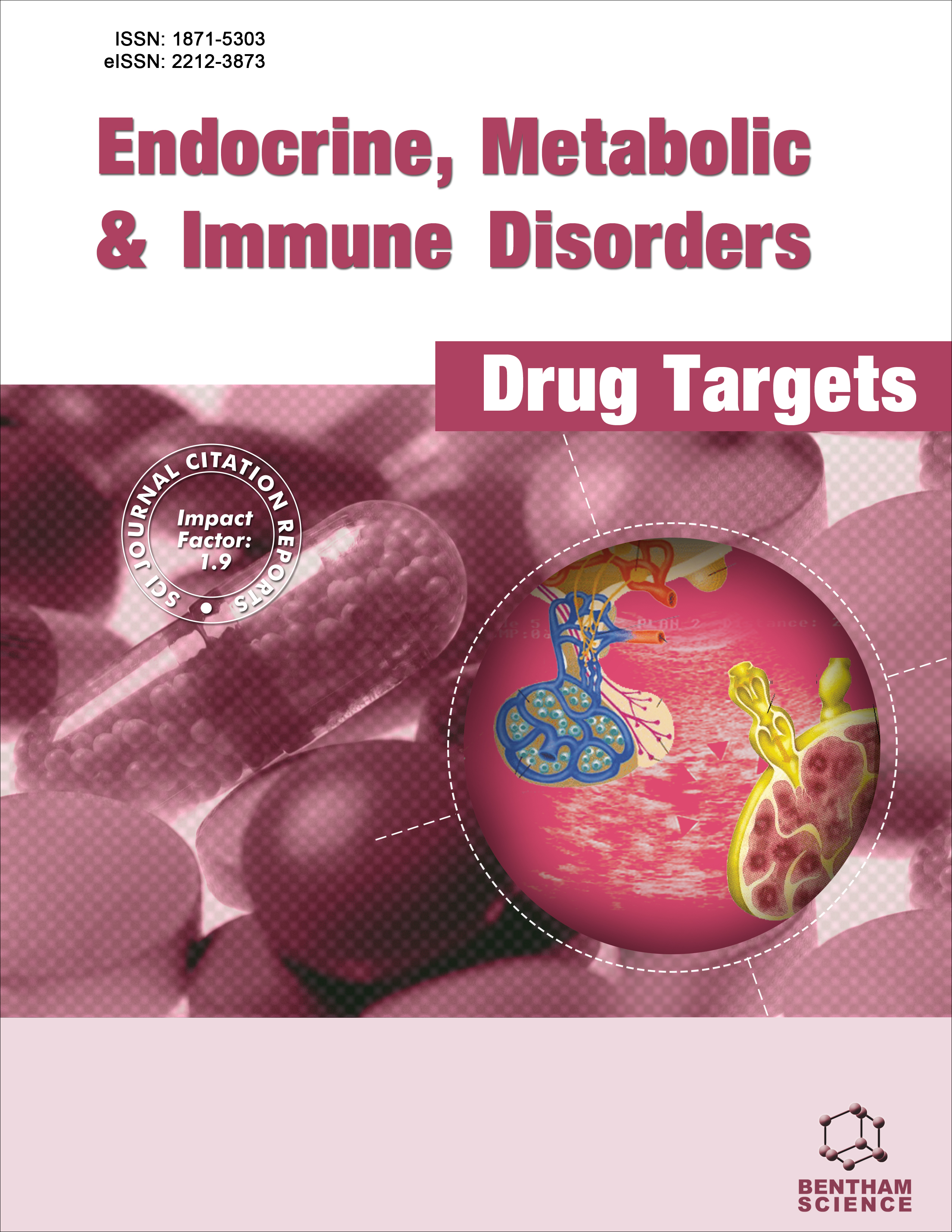- Home
- A-Z Publications
- Endocrine, Metabolic & Immune Disorders-Drug Targets (Formerly Current Drug Targets - Immune, Endocrine & Metabolic Disorders)
- Previous Issues
- Volume 10, Issue 4, 2010
Endocrine, Metabolic & Immune Disorders-Drug Targets (Formerly Current Drug Targets - Immune, Endocrine & Metabolic Disorders) - Volume 10, Issue 4, 2010
Volume 10, Issue 4, 2010
-
-
EDITORIAL [Hot topic: Tissue Fibrosis (Guest Editor: Shizuya Saika)]
More LessWound healing process may lead to undesirable outcome, tissue fibrosis or scarring, and affect the organ function in various organs. Body surface, i. e., skin, mucosa including ocular surface, directly receive external stimuli, and injured.Excess scarring in such tissues is to be prevented to maintain their function or an outward appearance of a patient. Surface epithelium and underlying mesenchymal cells, as well as inflam Read More
-
-
-
Integrins Modulate Cellular Fibrogenesis at Multiple Levels: Regulation of TGF-β Signaling
More LessFibrosis could occur in virtually any organ or tissue. The fibrotic lesion indolently disrupts the structure of the healthy organ, thereby hampering its proper function, consequence of which is devastating. Among the myriad factors that modulate fibrogenesis, transforming growth factor β (TGF-β) is one of the most studied and its central role for fibrotic disorders has been strongly suggested. Due to the pleiotropic nature of this cyt Read More
-
-
-
Wound-Associated Skin Fibrosis: Mechanisms and Treatments Based on Modulating the Inflammatory Response
More LessAuthors: Tanya J. Shaw, Kazuo Kishi and Ryoichi MoriSkin fibrosis, in its mildest form, may present only a minor aesthetic problem, but in the most severe cases it can lead to debilitating pathologies of the skin, for example keloid and hypertrophic scars, and systemic sclerosis. In recent years, extensive basic research aimed at understanding the molecular mechanisms underlying fibrosis has revealed an impressive but baffling number of genes, molecules, and cell types that may Read More
-
-
-
Fibrosis in the Anterior Segments of the Eye
More LessAuthors: Osamu Yamanaka, Chia-Yang Liu and Winston W.-Y. KaoThe anterior segment of the eye ball, i. e., cornea and conjunctiva, serves as the barrier to the external stimuli. Cornea is transparent and is a “window” of the light sense, while conjunctiva covers the sclera, the main part of the eyeshell. Fibrosis/scarring in cornea potentially impairs vision by the reduction of its transparency and the alteration of the regular curvature. Fibrotic reaction in conjunctiva is also of clinical importa Read More
-
-
-
The Leptin System: A Potential Target for Sepsis Induced Immune Suppression
More LessSepsis, which is defined as a systemic inflammatory response syndrome that occurs during infection, is associated with several clinical conditions and high mortality rates. As sepsis progresses immune paralysis can become severe, leaving an already vulnerable patient ill equipped to eradicate primary or secondary infections. At present the predominant treatments for sepsis have not demonstrated convincing efficacy of decre Read More
-
-
-
Isoforms of Vitamin E Differentially Regulate Inflammation
More LessAuthors: Joan M. Cook-Mills and Christine A. McCaryVitamin E regulation of disease has been extensively studied in humans, animal models and cell systems. Most of these studies focus on the α-tocopherol isoform of vitamin E. These reports indicate contradictory outcomes for anti-inflammatory functions of the α-tocopherol isoform of vitamin E, especially with regards to clinical studies of asthma and atherosclerosis. These seemingly disparate clinical results are consist Read More
-
-
-
PKC- is a Drug Target for Prevention of T Cell-Mediated Autoimmunity and Allograft Rejection
More LessAuthors: Myung-Ja Kwon, Ruiqing Wang, Jian Ma and Zuoming SunProtein kinase C theta (PKC-) is a key kinase in mediating T cell receptor (TCR) signals. PKC- activated by T cell receptor (TCR) engagement translocates to immunological synapses and regulates the activation of transcriptional factors NF-κB, AP-1, and NFAT. These transcription factors then activate target genes such as IL-2. T cells deficient in PKC- display defects in T cell activation, survival, activation-induced cell deat Read More
-
Volumes & issues
-
Volume 25 (2025)
-
Volume 24 (2024)
-
Volume 23 (2023)
-
Volume 22 (2022)
-
Volume 21 (2021)
-
Volume 20 (2020)
-
Volume 19 (2019)
-
Volume 18 (2018)
-
Volume 17 (2017)
-
Volume 16 (2016)
-
Volume 15 (2015)
-
Volume 14 (2014)
-
Volume 13 (2013)
-
Volume 12 (2012)
-
Volume 11 (2011)
-
Volume 10 (2010)
-
Volume 9 (2009)
-
Volume 8 (2008)
-
Volume 7 (2007)
-
Volume 6 (2006)
Most Read This Month
Article
content/journals/emiddt
Journal
10
5
false
en


